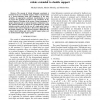202 search results - page 18 / 41 » Hybrid Control for Biped Robots Using Impedance Control and ... |
IROS
2008
IEEE
14 years 2 months ago
2008
IEEE
— One of the main challenges in telerobotics is the selection of control architectures and control parameters, which are able to robustly stabilize the overall teleoperation syst...
AE
2009
Springer
13 years 8 months ago
2009
Springer
This paper reports on a feasibility study into the evolution of robot controllers during the actual operation of robots (on-line), using only the computational resources within the...
CONNECTION
2004
13 years 7 months ago
2004
The Artificial Life approach to Evolutionary Robotics is used as a fundamental framework for the development of a modular neural control of autonomous mobile robots. The applied e...
CDC
2009
IEEE
13 years 11 months ago
2009
IEEE
The concept of virtual holonomic constraints is extended to the case of double support, which is characterized by a closed kinematic chain and redundancy in the state variables. An...
ISER
1995
Springer
13 years 11 months ago
1995
Springer
Most robot designers make the mechanical interface between an actuator and its load as stiff as possible[9][10]. This makes sense in traditional position-controlled systems, becau...

